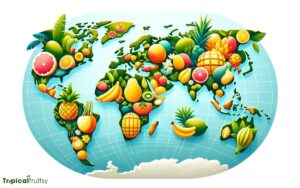Difference Between Tropical and Temperate Fruits: Explore!
The difference between tropical and temperate fruits lies in their optimal growing environments and the resulting distinctions in flavor, appearance, and nutritional profile.
Tropical fruits, such as bananas, lychees, and coconuts, are cultivated in warm, moist climates typical of regions near the equator. These fruits are known for their bright colors and exotic tastes.
On the other hand, temperate fruits like apples, plums, and berries grow best in cooler climates with clear seasonal variations, offering a different range of tastes and textures.
Tropical fruits typically thrive in regions with a consistent year-round temperature above 20°C (68°F) and high humidity levels. They cannot tolerate frost and require a long growing season.
Examples include:
Temperate fruits grow in areas where winter temperatures drop below 7°C (45°F) but not so cold as to damage the plant. These fruits often require a period of cold dormancy to fruit properly.
Examples include:
Fruits are a reflection of their native climates, with tropical varieties offering a burst of sunshine and temperate fruits embodying the changing seasons.

Key Takeaway
8 Features: Tropical Fruits and Temperate Fruits
| Feature | Tropical Fruits | Temperate Fruits |
|---|---|---|
| Climate | Warm and humid | Moderate with seasonal changes |
| Temperature | Above 20°C (68°F) | Below 7°C (45°F) in winter |
| Seasonality | Year-round growth | Clear seasonal growth cycles |
| Frost Tolerance | None | Some, with required chill hours |
| Examples | Mango, Pineapple, Avocado | Apple, Cherry, Grape |
| Taste | Often sweet and juicy | Range from sweet to tart |
| Texture | Varied, from soft to fibrous | Generally firmer |
| Nutritional Content | High in vitamins, fiber | Diverse, often high in antioxidants |
Defining Tropical Fruits
Within the context of climatic adaptation, tropical fruits are typically defined as those cultivated primarily in regions situated between the Tropics of Cancer and Capricorn. In these regions, the climate is characterized by high temperatures and year-round precipitation.
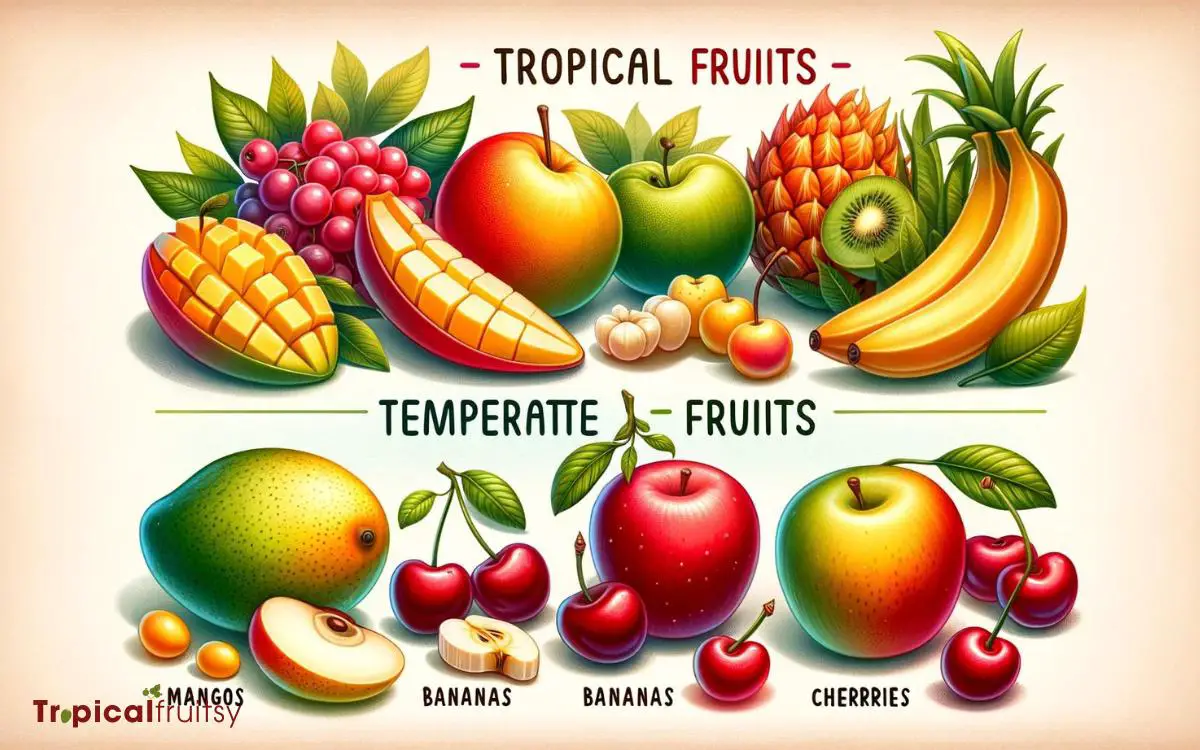
This equatorial belt fosters the growth of a diverse array of fruit species that are not only integral to the local ecosystems but also have adapted to the specific humidity, soil types, and photoperiod conditions.
The metabolic pathways and physiological mechanisms of these fruits often reflect their adaptation to minimize water loss and to exploit the consistent climatic conditions. This adaptation leads to a rich variety in flavor, nutrition, and form.
As we turn our focus from the tropical zones to more temperate regions, it is evident that the characteristics of temperate fruits diverge markedly from their tropical counterparts.
Characteristics of Temperate Fruits
Temperate fruits, in contrast to their tropical counterparts, thrive in regions with distinct seasonal changes and cooler climates, exhibiting unique adaptations to these environments.
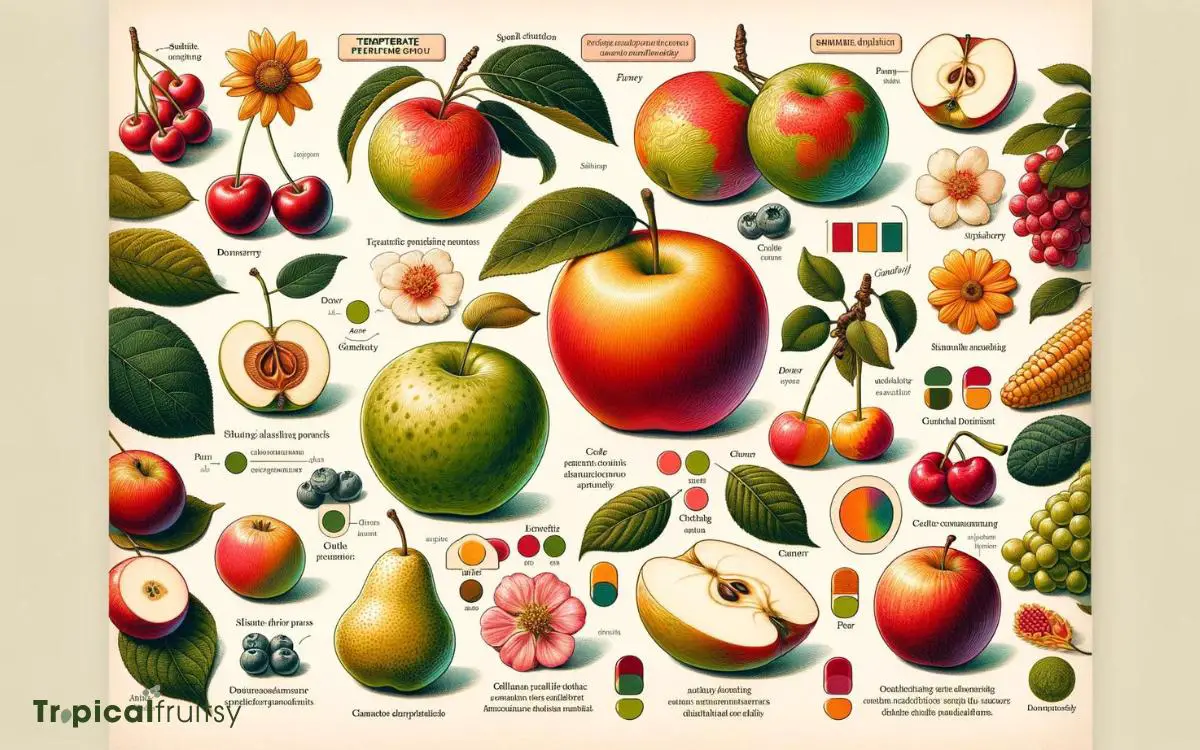
The temperate climate offers a moderate growing season followed by a period of dormancy, which many fruits require to develop properly.
This dormancy period often initiates biochemical processes essential for fruit maturation and flavor development.
The characteristics of temperate fruits can be attributed to their specific adaptations to the temperate climate.
Deciduous nature:
Most temperate fruit trees shed their leaves annually, preparing for winter dormancy. This adaptation allows the trees to conserve energy and protect themselves from the harsh winter conditions.
Cold hardiness:
Temperate fruit species have evolved mechanisms to survive freezing temperatures. These mechanisms include the production of antifreeze compounds and the ability to enter a dormant state during periods of extreme cold.
Longer growth cycles:
These fruits generally require a longer maturation period, contributing to their complex flavor profiles. The gradual development allows for the accumulation of sugars and other compounds that contribute to the taste and texture of the fruit.
An analysis of temperate fruits reveals that their growth and development are deeply intertwined with the cyclical patterns of their native climates, which in turn influences their nutritional content, taste, and texture.
These fruits have adapted to take advantage of the temperate climate’s distinct seasonal changes and cooler temperatures, resulting in unique characteristics that set them apart from their tropical counterparts.
Climatic Influences on Growth
The growth patterns of tropical and temperate fruit species are fundamentally influenced by climatic variables such as ambient temperature and precipitation patterns.
Temperature extremes can induce physiological stress in plants, affecting fruit set, development, and ripening, while optimal temperature ranges promote metabolic processes essential for growth.
Meanwhile, rainfall variability can alter soil moisture content, influencing nutrient uptake and, consequently, the yield and quality of the fruit crop.
Temperature Impact
During their respective growing seasons, tropical and temperate fruits exhibit distinct developmental responses to climatic temperature variations.
Temperature plays a pivotal role in enzymatic activities, photosynthesis rates, and overall metabolic processes in plants.
In tropical fruits, consistently high temperatures ensure rapid growth and development, whereas temperate fruits require cooler conditions, often including a period of winter chill for successful fruit set and maturation.
To elucidate the significance of temperature on fruit growth, consider the following:
- High temperatures can induce stress in temperate fruit plants, leading to reduced yield and quality.
- Tropical fruits, when exposed to lower than optimal temperatures, may experience slowed metabolism, impacting ripening and sweetness.
- The precise temperature ranges conducive to each fruit type are critical for growers to maximize harvests, ensuring the fruits reach their full flavor and textural potential.
Rainfall Variability Effects
Rainfall patterns, as a second crucial climatic factor, significantly influence the growth and fruiting cycles of both tropical and temperate fruit species.
The distribution, intensity, and periodicity of rainfall can determine the success or failure of fruit production.
In tropical regions, where rain is abundant and often year-round, fruit trees benefit from a consistent water supply, which is vital for their growth and the development of juicy fruits.
Conversely, temperate fruits may experience a more varied rainfall pattern, often with a distinct wet and dry season that can affect flowering and harvest times.
| Climate Zone | Rainfall Characteristics |
|---|---|
| Tropical | High, year-round rainfall |
| Temperate | Seasonal variability |
| Tropical | Supports continuous growth |
| Temperate | Influences flowering/harvesting timing |
This climatic influence extends beyond mere survival; it shapes the very nature of the fruiting process.
As we transition into examining the ‘nutritional profiles compared’, it’s important to consider how these climatic factors might affect the biochemical composition of the fruits.
Nutritional Profiles Compared
Regarding nutritional content, tropical and temperate fruits exhibit distinct profiles, with variations in vitamins, minerals, and phytochemicals that reflect their adaptation to different climatic conditions.
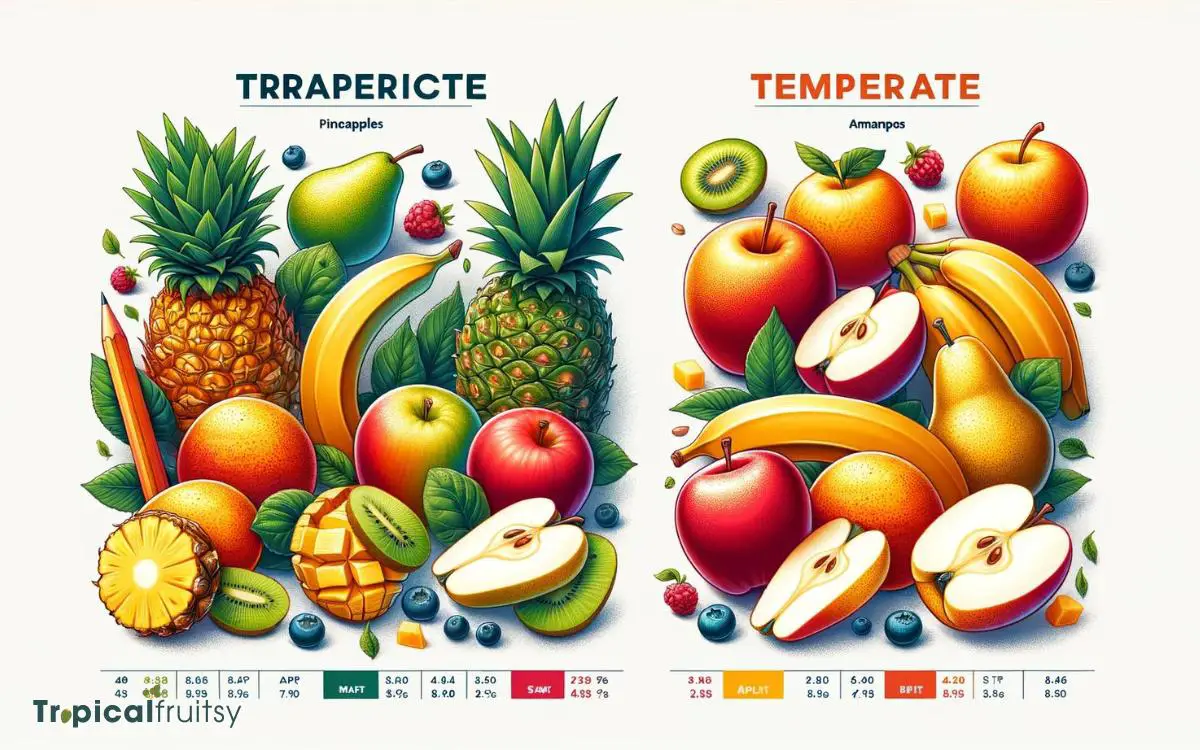
Tropical fruits often have high levels of vitamin C and other antioxidants to protect against the intense solar radiation they experience.
In contrast, temperate fruits may possess higher concentrations of storage-related compounds like fiber due to the necessity to endure longer periods between growing seasons.
- Vitamin C: Tropical fruits typically offer a richer source of this potent antioxidant, vital for immune function.
- Dietary Fiber: Temperate fruits often contain more fiber, supporting digestive health and satiety.
- Phytochemical Diversity: A varied array of phytochemicals in both fruit types contributes to a broad spectrum of health benefits.
These nutritional differences are significant for dietary planning and underline the importance of consuming a variety of fruits to obtain a balanced intake of nutrients.
Harvesting and Seasonality
The seasonality of tropical and temperate fruits significantly influences their harvesting times, reflecting the climatic adaptations previously noted in their nutritional profiles.
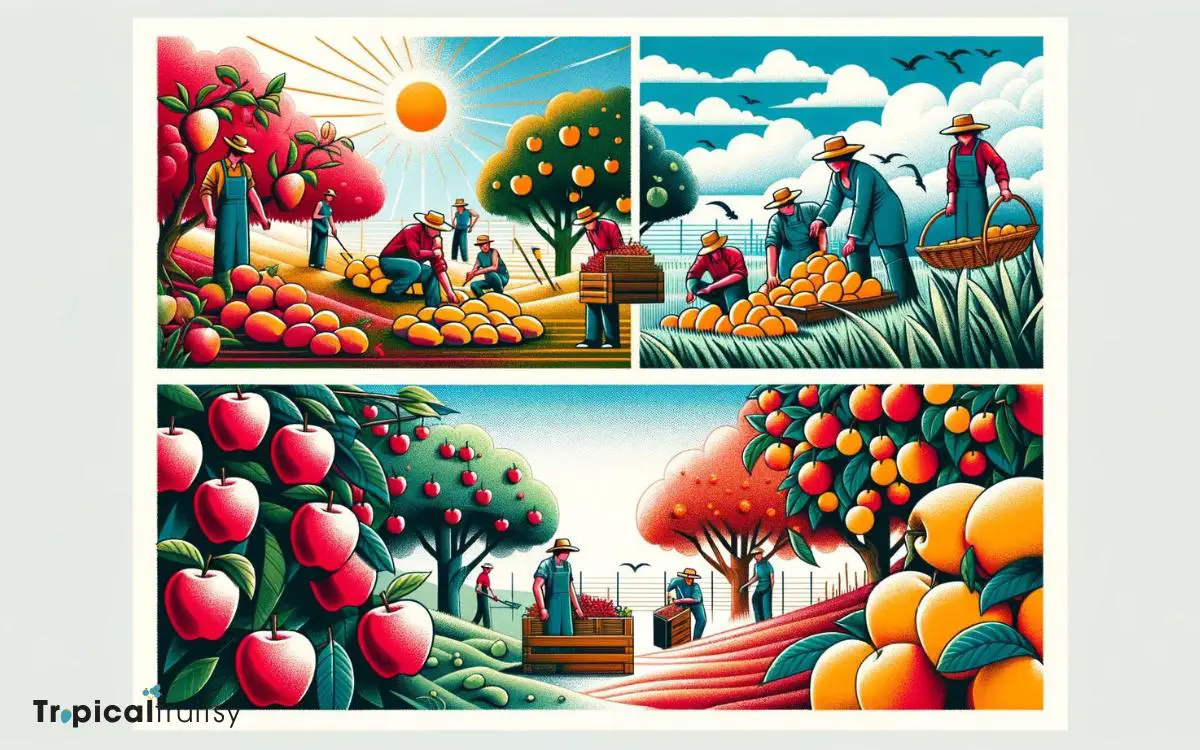
Tropical fruits often require a consistent, year-round warm climate, leading to less pronounced seasonal variation.
Conversely, temperate fruits typically have a distinct growing season, correlating with a temperate region’s cooler months.
| Fruit Type | Typical Harvesting Season | Climatic Requirements |
|---|---|---|
| Tropical Fruits | Year-round | Constant warmth |
| Temperate Fruits | Late Spring to Early Fall | Cooler, seasonal |
| Apples | Fall | Cold winters, warm summers |
| Mangoes | Late Spring to Early Fall | Tropical, frost-free |
| Cherries | Summer | Moderate temperatures |
Through this lens, we can deduce that the harvest period is a direct manifestation of each fruit’s ecological niche. This facet not only influences availability but also impacts storage, transport, and market prices.
These factors, in turn, subtly shape the culinary uses and preferences in different cultures, which is the focus of our next discussion.
:What are the key differences between tropical and subtropical fruits compared to temperate fruits?
Tropical and subtropical fruits thrive in warm climates with plenty of sun, while temperate fruits grow in cooler regions. The key difference between them is the climate they require to grow. Tropical and subtropical fruits, such as mangoes and pineapples, need hot and humid environments, while temperate fruits like apples and pears prefer cooler temperatures. When you compare tropical and subtropical fruits to temperate fruits, you’ll notice a significant difference in the conditions necessary for their cultivation.
Culinary Uses and Preferences
Exploring the culinary uses and preferences of tropical and temperate fruits reveals a diverse gastronomic landscape shaped by their availability and regional tastes.
Tropical fruits like mangoes, pineapples, and papayas are often used fresh in dishes, capitalizing on their vibrant flavors and textures.

They’re essential in sweet and savory pairings, lending a unique profile to salsas, chutneys, and glazes for meats.
In contrast, temperate fruits such as apples, pears, and berries are frequently incorporated into baked goods, preserves, and beverages, reflecting their compatibility with longer storage and cooking processes.
The succulent sweetness of tropical fruits ignites a sensory celebration in summer salads and desserts. The comforting aroma of temperate fruits infuses warmth into pies, ciders, and jams.
The contrasting tang and zest of these fruits inspire innovative culinary fusions, marrying traditions across continents.
Conclusion
In the intricate tapestry of horticulture, tropical and temperate fruits emerge as distinct threads, each colored by their unique environmental canvases.
Tropical fruits, adorned with vibrant hues and exotic flavors, dance to the rhythm of perpetual summer, while temperate fruits carry the subtle notes of seasonal change.
Their divergent growth climates weave a rich mosaic of nutritional diversity and culinary potential, reflecting the Earth’s splendid variation, and offering a cornucopia that nourishes and delights the palate of humanity.




